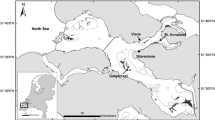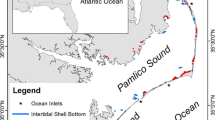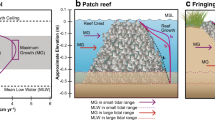Abstract
Oyster reef restoration in shallow estuarine environments has been thought to have the potential to provide shoreline protection as well as oyster habitat. This study was designed to address the question of how effective oyster reefs are at attenuating wave energy in shallow coastal bays. Measurements were made of waves on both sides of four restored intertidal oyster reefs and at a control site with no reef; mean water depths ranged from 0.9 to 1.3 m. The reefs differed in composition and position relative to the shoreline, but all had reef crest elevations between 0.3 and 0.5 m below mean sea level. Differences in wave heights between the exposed/sheltered sides and upwind/downwind sides of the reefs were used to quantify the effects of the reefs on waves under varying tidal and wind conditions. All four reefs were able to reduce wave heights by an average of 30–50% for water depths of 0.5–1.0 m (bracketing the heights of reef crests) and 0–20% for water depths of 1.0–1.5 m (reef crests > 0.25 m below the water surface). For water depths greater than 1.5 m, there was < 10% change in wave heights. In contrast, there was no average decrease in wave height from the more seaward (exposed) to the more landward wave gauge at the control site regardless of water depth. Based on our results, we conclude that fringing oyster reefs can reduce the wave energy reaching the shoreline of marshes with edge elevations close to mean sea level. However, reefs like those in our study have little effect on waves during deeper water conditions, which allow for the largest waves, and are therefore less likely to offer protection to marshes characterized by high edge scarps and marsh surface elevations well above mean sea level.










Similar content being viewed by others
References
Coen, L.D., R.D. Brumbaught, D. Bushek, R. Grizzle, M.W. Luckenbach, M.H. Posey, S.P. Powers, and S.G. Tolley. 2007. Ecosystem services related to oyster restoration. Marine Ecology Progress Series 341: 303–307.
Dame, R.F., and B.C. Patten. 1981. Analysis of energy flows in an intertidal oyster reef. Marine Ecology Progress Series 5: 115–124.
Day, J.W., Jr., F. Scarton, A. Rismondo, and D. Are. 1998. Rapid deterioration of a salt marsh in Venice lagoon, Italy. Journal of Coastal Research 14: 583–590.
Drexler, M., M.L. Parker, S.P. Geiger, W.S. Arnold, and P. Hallock. 2014. Biological assessment of eastern oysters (Crassostrea virginica) inhabiting reef, mangrove, seawall, and restoration substrates. Estuaries and Coasts 37 (4): 962–972. https://doi.org/10.1007/s12237-013-9727-8.
Emery, K.A. 2015. Man and boy marsh shoreline change. Report for The Nature Conservancy.
Fagherazzi, S., L. Carniello, L. D’Alpaos, and A. Defiina. 2006. Critical bifurcation of shallow microtidal landforms in tidal flats and salt marshes. Proceedings of the National Academy of Sciences 103 (22): 8337–8341. https://doi.org/10.1073/pnas.0508379103.
Fagherazzi, S., G. Mariotti, J.H. Porter, K.J. McGlathery, and P.L. Wiberg. 2010. Wave energy asymmetry in shallow bays. Geophysical Research Letters 72 (24): L24601. https://doi.org/10.1029/2010GL045254.
Fagherazzi, S., P.L. Wiberg, S. Temmerman, E. Struyf, Y. Zhao, and P.A. Raymond. 2013. Fluxes of water, sediment, and biogeochemical compounds in salt marshes. Ecological Processes 2 (1): 3.
Ferguson, A.E. 2018. Evaluating nature-based solutions to storm wave impacts in the Virginia coast reserve. M.S. Thesis, University of Virginia, Charlottesville, VA, 188 pp.
Huang, Z.-C., L. Lenain, W.K. Melville, J.H. Middleton, B. Reineman, N. Statom, and R.M. McCabe. 2012. Dissipation of wave energy and turbulence in a shallow coral reef lagoon. Journal of Geophysical Research 117: C03015. https://doi.org/10.1029/2011JC007202.
Jackson, C.W., C.R. Alexander, and D.M. Bush. 2012. Application of the AMBUR R package for spatio-temporal analysis of shoreline change: Jekyll Island, Georgia, USA. Computers & Geosciences 41: 199–207. https://doi.org/10.1016/j.cageo.2011.08.009.
Kathilankal, J.C., T.J. Mozdzer, J.D. Fuentes, P. D’Odorico, K.J. McGlathery, and J.C. Zieman. 2008. Tidal influences on carbon assimilation by a salt marsh. Environmental Research Letters 3 (4): 044010. https://doi.org/10.1088/1748-9326/3/4/044010.
Leonardi, N., N.K. Ganju, and S. Fagherazzi. 2016. A linear relationship between wave power and erosion determines salt-marsh resilience to violent storms and hurricanes. Proceedings of the National Academy of Sciences 113 (1): 64–68. https://doi.org/10.1073/pnas.1510095112.
Lowe, R.J., J.L. Falter, M.D. Bandet, G. Pawlak, M.J. Atkinson, S.G. Monismith, and J.R. Koseff. 2005. Spectral wave dissipation over a barrier reef. Journal of Geophysical Research 110: C04001. https://doi.org/10.1029/2004JC002711.
Malhotra, A., and M.S. Fonseca. 2007. WEMo (Wave Exposure Model): Formulation, Procedures and Validation.NOAA Technical Memorandum NOS NCCOS 65. NOAA/National Ocean Service/National Centers for Coastal Ocean Science, Beaufort, NC, 28 pp.
McLoughlin, S.M., P.L. Wiberg, I. Safak, and K.J. McGlathery. 2015. Rates and forcing of marsh edge erosion in a shallow coastal bay. Estuaries and Coasts 38 (2): 620–638. https://doi.org/10.1007/s12237-014-9841-2.
Marani, M., A. D’Alpaos, S. Lanzoni, and M. Santalucia. 2011. Understanding and predicting wave erosion of marsh edges. Geophysical Research Letters 38 (21): L21401. https://doi.org/10.1029/2011GL048995.
Mariotti, G., and S. Fagherazzi. 2013. Critical width of tidal flats triggers marsh collapse in the absence of sea-level rise. Proceedings of the National Academy of Sciences 110 (14): 5353–5356. https://doi.org/10.1073/pnas.1219600110.
Meyer, D.L., E.C. Townsend, and G.W. Thayer. 1997. Stabilization and erosion control value of oyster cultch for intertidal marsh. Restoration Ecology 5 (1): 93–99.
Möller, I., T. Spencer, J.R. French, D.J. Leggett, and M. Dixon. 1999. Wave transformation over salt marshes: a field and numerical modeling study from North Norfolk, England. Estuarine Coastal and Shelf Science 49 (3): 411–426.
Möller, I., M. Kudella, F. Rupprecht, T. Spencer, M. Paul, B.K. van Wesenbeeck, G. Wolters, K. Jensen, T.J. Bouma, M. Miranda-Lange, and S. Schimmels. 2014. Wave attenuation over coastal salt marshes under storm surge conditions. Nature Geoscience 7 (10): 727–731. https://doi.org/10.1038/ngeo2251.
Morris, J.T., P.V. Sundareshwar, C.T. Nietch, B. Kjerfve, and D.R. Cahoon. 2002. Responses of coastal wetlands to rising sea level. Ecology 83 (10): 2869–2877.
Piazza, B.P., P.D. Banks, and M.K. La Peyre. 2005. The potential for created oyster shell reefs as a sustainable shoreline protection strategy in Louisiana. Restoration Ecology 13 (3): 499–506.
Rodriguez, A.B., F.J. Fodrie, J.T. Ridge, N.L. Lindquist, E.J. Theuerkauf, S.E. Coleman, J.H. Grabowski, M.C. Brodeur, R.K. Gittman, D.A. Keller, and M.D. Kenworthy. 2014. Oyster reefs can outpace sea-level rise. Nature Climate Change 4 (6): 493–497. https://doi.org/10.1038/nclimate2216.
Safak, I., P.L. Wiberg, M.O. Kurum, and D.L. Richardson. 2015. Controls on residence time and exchange in a system of shallow coastal bays. Continental Shelf Research 97: 7–20. https://doi.org/10.1016/j.csr.2015.01.009.
Schwimmer, R.A. 2001. Rates and processes of marsh shoreline erosion in Rehoboth Bay, Delaware, U.S.A. Journal of Coastal Research 17: 672–683.
Scyphers, S.B., S.P. Powers, K.L. Heck Jr., and D. Byron. 2011. Oyster reefs as natural breakwaters mitigate shoreline loss and facilitate fisheries. PLoS One 6 (8): e22396. https://doi.org/10.1371/journal.pone.0022396.
Stricklin, A.G., M.S. Peterson, J.D. Lopez, C.A. May, C.F. Mohrann, and M.S. Woodrey. 2009. Do small, patchy, constructed intertidal oyster reefs reduce salt marsh erosion as well as natural reefs? Gulf and Caribbean Research 22: 21–27.
Taube, S.R. 2013. Impacts of fringing oyster reefs on wave attenuation and marsh erosion rates. M.S. thesis, University of Virginia, Charlottesville, VA, 157pp.
Theuerkauf, S.J., R.P. Burke, and R.N. Lipcius. 2015. Settlement, growth, and survival of eastern oysters on alternative reef substrates. Journal of Shellfish Research 34: 241–250. https://doi.org/10.2983/035.034.0205.
Tonelli, M., S. Fagherazzi, and M. Petti. 2010. Modeling wave impact on salt marsh boundaries. Journal of Geophysical Research 115: C09028. https://doi.org/10.1029/2009JC006026.
van der Wal, D., and K. Pye. 2004. Patterns, rates and possible causes of saltmarsh erosion in the Greater Thames area (UK). Geomorphology 61: 373–391.
Whitman, E.R., and M.A. Reidenbach. 2012. Benthic flow environments affect recruitment of Crassostrea virginica larvae to an intertidal oyster reef. Marine Ecology Progress Series 463: 117–191.
Wiberg, P.L., and C.R. Sherwood. 2008. Calculating wave-generated bottom orbital velocities from surface-wave parameters. Computers & Geosciences 34 (10): 1243–1262.
Wilson, C.A., and M.A. Allison. 2008. An equilibrium profile model for retreating marsh shorelines in Southeast Louisiana. Estuarine Coastal and Shelf Science 80 (4): 483–494.
Woodhouse, W.E., Jr., and P.L. Knutson. 1982. Atlantic coastal marshes. In Creation and restoration of coastal plant communities, ed. R.R. Lewis III. Boca Raton: CRC Press, Inc. 219 p.
Wray, R.D., S.P. Leatherman, and R.J. Nicholls. 1995. Historic and future land loss for upland and marsh islands in the Chesapeake Bay, Maryland, U.S.A. Journal of Coastal Research 11: 1195–1203.
Wunsch, C., and D. Stammer. 1997. Atmospheric loading and the oceanic “inverted barometer” effect. Reviews of Geophysics 35 (1): 79–107.
Acknowledgements
We thank the staff of the Anheuser-Busch Coastal Research Center and The Nature Conservancy for logistical support, particularly David Boyd (ABCRC) and Bo Lusk (TNC).
Funding
This research was supported by the National Science Foundation through the VCR LTER award 1237733 and by a grant from the National Fish and Wildlife Foundation to The Nature Conservancy (2300.14.042551).
Author information
Authors and Affiliations
Corresponding author
Additional information
Communicated by Carl T. Friedrichs
Electronic Supplementary Material
ESM 1
(PDF 794 kb)
Rights and permissions
About this article
Cite this article
Wiberg, P.L., Taube, S.R., Ferguson, A.E. et al. Wave Attenuation by Oyster Reefs in Shallow Coastal Bays. Estuaries and Coasts 42, 331–347 (2019). https://doi.org/10.1007/s12237-018-0463-y
Received:
Revised:
Accepted:
Published:
Issue Date:
DOI: https://doi.org/10.1007/s12237-018-0463-y




